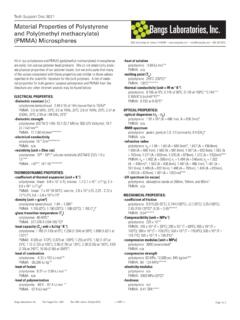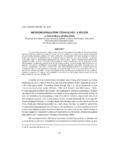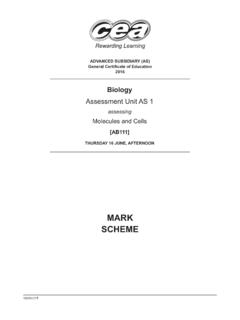Transcription of XXXVI. Paper and board for food contact
1 This is an unofficial translation. Only the German version is binding. xxxvi . Paper and board for food contact As of Preamble 1. This Recommendation is valid for single and multi-layered commodities (articles, materials). made of Paper or paperboard which are intended to come into contact with or affect food- stuffs. It includes Paper or paperboard which is intended to be used at temperatures up to 90 C (holding and reheating of food). For the following listed special applications ( higher temperature range) the respective special Recommendation has to be noted: - For Paper that in its intended use will be subject to hot extraction (boil-in-bag packages, tea bags, hot filter papers), and for filter layers that in their intended use will be subject to extraction (filtration) Recommendation xxxvi /1 applies.
2 - For Paper , paperboard and board which comes into contact with or affects foodstuffs dur- ing baking Recommendation xxxvi /2 applies. This recommendation also applies for usage in microwave ovens. - For Absorber pads based on cellulosic fibres for food packaging Recommendation xxxvi /3 applies. 2. Regarding the substance groups that are covered by this Recommendation the following restrictions have to be noted: a) This Recommendation applies to raw materials (section A), production aids (section B), and special Paper refining agents (section C) used in the production process for Paper , pa- perboard and board that comes into contact with foodstuffs. Moreover, in the Paper produc- tion process substances are used to keep manufacturing devices clean and to protect them from corrosion. This Recommendation shall not apply for these substances.
3 The manufac- turer or distributor of the Paper is responsible to comply to food regulations (especially Regulation (EU) No. 1935/2004) for these substances1. However, substances listed in this Recommendation subject to the above stated applications were listed before 2013. b) Substances that are used for manufacturing of Paper raw materials listed in section A or substances that are used for formulation of active ingredients listed in section B and C ( emulsifiers, solvents, set-up chemicals, stabilizer, pH modifiers) are not subject to this BfR- Recommendation. For their application requirements of article 3 of the Regulation (EU) No. 1935/2004 shall be used1. However, substances listed in this Recommendation subject to the above stated applications were listed before 2013. Preservatives that are used to pre- vent microbial spoilage of formulations and slimicides are still covered by this Recommen- dation.
4 1 For guidance on compliance of the manufacturer's responsibility the following guidelines and assessments of substances may be used exemplarily: other Recommendations of the BfR, assessments of the European Food Safety Authority or the Scientific Committee on Food (SCF), Regulation (EU) No. 10/2011, European rules on food additives and drinking water. Moreover, an assessment can be made by the manufacturer on his own responsibil- ity. Page 1 of 17. Federal Institute for Risk Assessment c) If slimicides and preservatives are used that have limit values according to (EG) Nr. 396/2005, these values are also valid for the migration from Paper . 3. Methods for testing commodities (materials and articles) made of Paper or paperboard are available under 4. The finished Paper or paperboard must have no preserving effect on the foodstuffs with which they come into contact2.
5 5. To the extent that in this Recommendation the use of certain substances is restricted the maximum quantities given, if not applied to surface area or otherwise stated, refer to the dry finished product. 6. If in the production of a certain Paper or paperboard a particular production aid, on account of its wide spectrum of use, is listed more than once in the Recommendation, the largest maximum amount given is to be taken as the in total maximum. Adding the different max- imum amounts together is not permissible. 7. No more than 10 g/l lead and 5 g/l cadmium must be detectable in the cold water extract of the finished 8. The migration of aluminium into foodstuffs must not exceed 1 mg/kg4,5. Compliance with this requirement can be checked in the cold water 9. Azo dyes after Annex 1, No.
6 7 ( 3) of the Commodities Regulation (Bedarfsgegenst nde- verordnung), must not be used in the manufacture of food- contact Paper or Paper 10. In a composite, multi-layered or coated material, if the layer which comes into contact with the foodstuff is made of Paper or paperboard it must comply with this Recommendation. Al- so, except for traces that are harmless to health and have no effect on taste or smell of the foodstuff, there must be no migration of substances from other layers into foodstuffs or on their surface. 11. Optical brighteners must not migrate to the foodstuff. Testing is conducted according to DIN. EN 6483, whereby a value of 5 on the evaluation scale must be reached. 12. Examples of application of DIN EN 646 and DIN EN 648 for the determination of color fast- ness are listed in the BfR method compilation.
7 2 DIN EN 1104: Determination of the transfer of antimicrobial constituents . 3 Testing is not necessary for Paper and paperboard intended for contact with dry and at the same time non-fatty foodstuffs ( flour, semolina, rice, breakfast cereals, breadcrumbs, sugar and salt). 4 Testing is not necessary for Paper and paperboard intended for contact with exclusively fatty foodstuffs, such as butter or vegetable fats, as well as for foodstuffs which, according to Table 2 of Regulation (EU) No 10/2011, are to be tested exclusively with food simulant E. 5 If the actual use is not known, migration into food shall be tested with a surface area to packed food ratio of dm2/kg food under the worst foreseeable conditions of use regarding type and duration of contact , contact temper- ature and food.
8 6 For additional information on the determination of aluminium in water extract, see: Method collection Paper and paperboard ( ). 7 Detecting the use of prohibited azo dyes according to "Amtliche Sammlung von Untersuchungsverfahren nach 64 LFGB", method B Page 2 of 17. Federal Institute for Risk Assessment 13. When applied as specified, primary aromatic amines may not be released from the finished food contact material in a detectable amount. The detection limit is mg/kg food or food simulant and applies to the sum of the released primary aromatic amines. Additionally, pri- mary aromatic amines classified as carcinogens in classes 1A and 1B of the CLP Regula- tion (EC) 1272/2008 may not be released referred to the single substance with a detection limit of mg/kg food or food There are no objections to the use of Paper or paperboard in the manufacture of commodities in the sense of 2, Para.
9 6, No. 1 of the Food and Feed Code (Lebensmittel- und Futtermit- telgesetzbuch (LFGB)), provided they are suitable for their intended purpose and comply also with the following conditions: A. Raw materials9. The following raw materials may be used: I. Fibrous materials: 1. Natural and synthetic cellulose fibres, bleached or unbleached. 2. Fibres of synthetic high polymers, provided they comply with the prevailing requirements of food law. 3. Wood pulp, bleached or unbleached. 4. Recycled fibres made from Paper or paperboard provided that the finished articles comply with the requirements in the annex of this Recommendation. II. Fillers: Insoluble minerals: 1. Carbonates of calcium and magnesium, silicon dioxide, silicates 2. Mixed silicates of sodium, potassium, magnesium, calcium, aluminium and iron 3.
10 Calcium sulfate 4. Calcium sulfoaluminate (satin white). 5. Barium sulfate (free of soluble barium compounds). 6. Titanium dioxide. 7. Magnesium hydroxide 8. Magnesium oxide 9. Aluminium hydroxide The fillers listed above must comply with the purity requirements stipulated under No. 3 in Recommendation LII. "Fillers". 10. Microspheres10 made from a copolymer of vinylidene chloride, methyl methacrylate and acrylonitrile, filled with isobutane, max. %, based on the dry fibres weight. 8 For the determination of primary aromatic amines in the water extracts see: Method collection Paper and Paper - board ( ). 9 Since 2013 additives to raw material are not subject for this Recommendation (see preamble, section 2). The fol- lowing substances were listed before 2013 and are still part of this Recommendation: a) Xylanase (There must be no detectable residual activity of this enzyme in the finished product.





